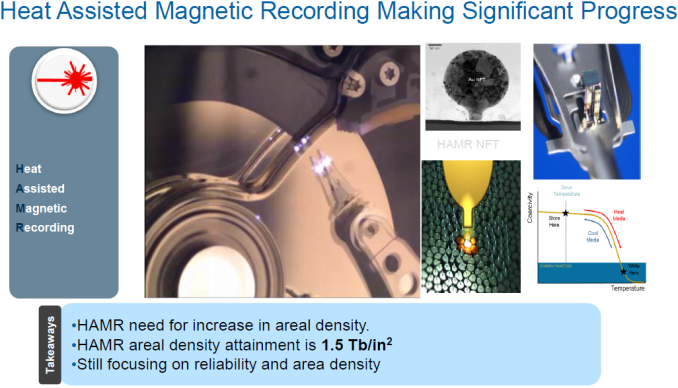The Evolution of HDDs in the Near Future: Speaking with Seagate CTO, Mark Re
by Anton Shilov on July 6, 2016 2:00 PM ESTHAMR: Over 2 Tb/inch2 and Onwards
As discussed above, SMR and TDMR technologies combined are expected to increase the areal density of HDD platters by approximately 10% to 20% compared to platters used inside of today’s hard drives. Seagate has done a lot to make SMR viable for a variety of applications and we are yet to see the fruits of TDMR. However, keeping in mind physical limitations of PMR and SMR as well as high-cost of helium-filled HDD tech (as of today, according to Seagate), a new magnetic recording technology is needed. Yes, we are (finally!) talking about HAMR.
Seagate says that its HAMR heads heat media to approximately 450°C using a laser with 810nm wavelength and 20mW power. Seagate’s current internal HAMR-based HDD have an areal density of about 2 Tb/inch2, which is considerably higher when compared to today’s PMR or SMR HDDs. Potentially, this means that Seagate can increase the capacity of hard drives by 2x just by employing the technology. In reality, not everything is that easy.
The device, which heats storage media, is called a near-field optical transducer (NFT). Hard drive makers use gold as the primary NFT material due to its superior optical properties. On the other hand, gold has a comparatively low mechanical strength and such NFTs may experience reflow at elevated temperatures resulting in deformation of the NFT shape. A deformation in shape can reduce coupling efficiency and reduce the amount of light energy transferred to the storage medium, which essentially means a damaged hard drive. This is why Seagate and other makers of HDDs have researched and patented a variety of materials (alloys based on gold, to be precise) for NFT for years now. Seagate does not reveal the alloy it uses for NFTs for now.
Nonetheless, Seagate stresses that when it ships its first HAMR-based HDDs for evaluation (in 2017) and then for commercial systems (in 2018), they will be rated to work for a long time, just like today’s hard drives. Seagate does not reveal any data about its HAMR-based HDDs for now, but claims that they can offer several writes per drive per day over five years, which suggests pretty high reliability. Eventually, client drives will also rely on HAMR, but those HDDs are pretty far away from us at this point.
The HDD maker is not disclosing any details when it comes to transducer materials. Apart from a durable NFT, HAMR-based HDDs will need a new head (featuring a heater, a writer, and several readers to mitigate the ITI effect), which means a lot of work both on hardware on multiple fronts. In the end, HAMR-based hard drives will aim to add both capacity and performance. But to make everything work, Seagate will have to develop a rather robust platform, which will involve complex controllers in addition to new materials and a number of other things.
It should be noted that HAMR is a challenge for the whole industry, not just for Seagate. As a result, as soon as the industry figures out how to make HAMR-based hard drives as reliable as traditional HDDs, the technology will be used right across the board.











91 Comments
View All Comments
mkozakewich - Thursday, July 7, 2016 - link
Oh, I remember that article. Higher write temperatures mean better longevity, right?twelvebore - Wednesday, July 6, 2016 - link
Guessing that you don't buy storage by the petabyte then? You know, horizons and all that.Ushio01 - Wednesday, July 6, 2016 - link
With 2.5" SSD's available today offer lower power, higher capacity, higher performance and higher density than 3.5" HDD's. I wonder how much that offsets the higher cost per GB?twelvebore - Wednesday, July 6, 2016 - link
Higher capacity? A 10TB 2.5" SSD for <£500? Where?Lower power than an HDD that's powered off?
Performance doesn't always matter.
The article says several times, this is not about desktop. This is about data-centre, extreme capacity, price-sensitive. These HDDs are competing with magnetic tape, not SSD.
jwhannell - Wednesday, July 6, 2016 - link
Flape.patrickjp93 - Wednesday, July 6, 2016 - link
Performance/Watt/$ is the most important metric, and HDD is already under immense pressure from archival SSDs.patrickjp93 - Wednesday, July 6, 2016 - link
For enterprise use that's a $2000 drive, unless you're using one without power loss protection and ECC... And Samsung already has one provided.Murloc - Wednesday, July 6, 2016 - link
It doesn't offset the cost at all if the only thing that matters is $/GB.amnesia0287 - Wednesday, July 6, 2016 - link
You don't seem to understand how datacenters work. SSDs and modern JBOD infrastructure are changing the way this is approached. The thing you gotta realize is you can pack SSDs INSANELY dense. Yes, the power difference of 1 ssd is menial, but when you fill a rack with them, the combined power and cooling savings add up, especially if you are aiming for a minimum 2-3 year run cost.You also have to bear in mind that datacenters are pretty much exclusively using substantially more expensive (and hotter/louder) SAS drives.
Capex is important, but you are totally ignoring Opex and TCO. Also AFR is about 1/6th (.5% vs 3%) which gives you more flexibity in your planing for consistency/redundancy. SSD failures are more or less predictable.
Either way the move to SSDs in the datacenter is VERY real, as density is king. Why waste money expanding into more datacenters and adding more racks? SSDs also solve alot of problems that HDD have such as large array rebuilds.
Also tech like RDMA combined with NVMe virtualization is going to fundamentally change the landscape.
zodiacfml - Friday, July 8, 2016 - link
Correct. SSDs have higher density already and the rich companies can afford them.